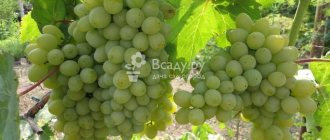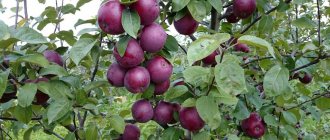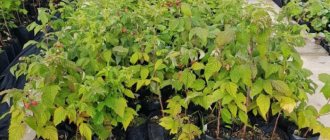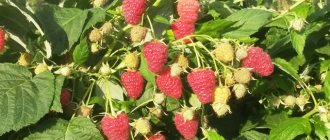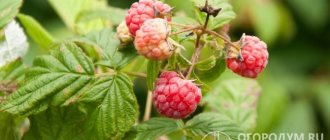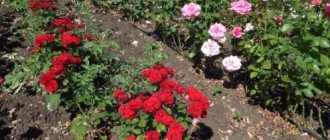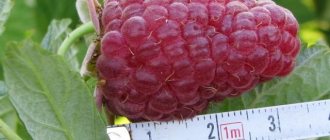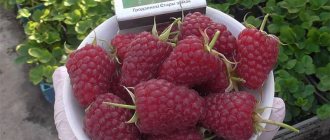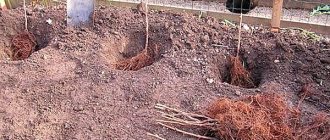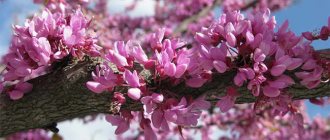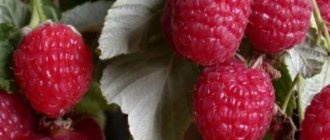It’s so nice when raspberry bushes bend under the weight of ripe berries. But due to cold winters and spring frosts, not every variety will take root in the middle zone. We'll look at those that definitely won't disappoint!
Autumn is a favorable time for planting raspberries. The bushes will take root well and produce a rich harvest if the procedure is carried out correctly and proper care is provided. But the main thing is to choose the right varieties that will allow you to enjoy plenty of healthy berries and make snacks for the winter.
Take note of the varieties from our selection!
Arbat – large-fruited mid-early raspberry variety
Raspberry Arbat is one of the most productive varieties in the Moscow region. It is distinguished by large elongated berries (15-18 g) of rich red color and high resistance to diseases. From one bush you can remove up to 9 kg of sweet raspberries per season. The berries are dense, store well and retain their shape during transportation. An adult bush is quite spreading - up to 2 m in height. There are no thorns on the stems, making the berries easy to pick. Raspberries ripen in early July and bear fruit until August. With regular fertilizing, the yield can be increased by 1.5-2 times. The bush of this variety bears fruit annually. Requires mandatory shelter for the winter.
Raspberry classification
Before considering the most valuable and interesting varieties of raspberries with photos and descriptions, we suggest you understand their diversity and classification. This will help you select planting material based on economic needs, personal preferences, and climatic characteristics of the region.
According to the method of fruiting
Depending on which shoots—the first or second year of growing season—fruits appear on, a distinction is made between summer and remontant raspberries.
The summer variety has a two-year development cycle. In the first year of the growing season, flower buds are laid in the axils of the leaves, and in the second year, fruit branches grow from them. The plant begins to bear fruit in June, extending the harvest for 1–1.5 months. The main problem, especially in regions with cold winters, is to preserve first-year shoots from freezing.
The summer fruitful raspberry varieties on our lips are Gusar, Maroseyka, Lashka, Octavia, Glen Ampl, Kaliningradskaya.
Remontant raspberries , unlike summer raspberries, complete the vegetation cycle from the growth of a young shoot to fruiting in one year. If you save the fruit-bearing branches, the next year it will produce two harvests - in the summer on old shoots and in the fall on young shoots. In the middle zone, it is recommended to grow it as an annual crop, getting one but abundant harvest. Remontant cultivars are large-fruited, have high yields, are subject to complete pruning for the winter, and therefore do not require shelter.
The most popular remontant varieties: Diamond, Hercules, Daughter of Hercules, Eurasia, Polka, Polana, Ruby Necklace, Indian Summer, Penguin.
This is interesting! The standard of raspberry taste is still the old Russian variety Novost Kuzmina, bred at the beginning of the 20th century. On its basis, more than a dozen new large-fruited cultivars have been bred, including Indian Summer, Bryanskaya, Vera, Coralovaya, Malakhovka, Meteor, Solnyshko.
According to ripening time
The earliest raspberry varieties begin to ripen in the second half of June, and late remontant varieties delight with juicy berries until frost.
- Beglyanka, Vera, Lazarevskaya, Novost Kuzmina, Lashka, Glen Ampl are the first to begin to mature.
- The mid-early group includes the varieties Blestyaschaya, Gusar, Maroseyka, Balsam, Yellow Giant, and Canby.
- They have late ripening periods: Firebird, Golden Autumn, Ruby, Coral, Brigantine, Terenty.
By berry size
There are traditional and large-fruited raspberry varieties:
- A regular raspberry weighs 2.5–4 g and tastes sweet. The advantage of traditional varieties is their endurance and unpretentiousness. They rarely freeze out, grow on the most ordinary soils, and are undemanding to care. And although their harvest is small, it is stable from year to year, and the quality of the berries is high. An example is Kuzmina News, Beglyanka, Meteor, Kaliningradskaya.
- Increasingly, gardeners want to grow large-fruited varieties. They have a lot of advantages - large berries up to 15 g with a delicate taste and aroma, high yield, density and transportability. The largest-fruited group includes: Arbat (15–18 g), Daughter of Hercules (up to 15 g), Ruby Necklace (12–14 g), Ruby Giant (up to 11 g), Patricia (up to 14 g), Yellow Giant (up to 10 g).
By berry color
The palette of raspberries contains many shades of red, there are yellow-fruited varieties (Beglyanka, Zolotoy Gigant, Apricot, Yellow Giant), orange-colored (Orange Miracle) and even black (Cumberland, Litach).
Chokeberry Cumberland
Standard plants
When choosing a raspberry variety, gardeners often pay attention to the height of the shoots, their stability or, conversely, their tendency to lodging, and the need for garter. In this regard, standard varieties of berry bushes are popular. Standard-type raspberries grow up to 1.5 m in height, have a thick and strong stem, are characterized by increased formation of lateral shoots (for this property they are compared to a raspberry tree), and do not require garter.
Popular standard varieties: Tarusa, Eurasia, Skazka, Krepysh, Monomakh's Cap.
This is interesting! Along with domestic varieties, raspberries of foreign selection are grown in Russia. The most popular English cultivars are Glen Ample, Glen Prosen, and Malling Promise; Polish - Polana, Polka, Lashka; German - Vislukha, Kaliningradskaya; American - Canby, Latham.
Brigantine is a mid-late variety of common raspberry
This variety will please its owners only closer to August, in the third ten days of July. But during this time, large and tasty fruits will ripen on the bushes! The weight of one raspberry sometimes reaches 3.8 g, and from one bush you can easily collect 2.5 kg of berries. Brigantine grows compactly. Its shoots are erect, there are few thorns and they are located sparsely. One of the advantages of the variety is its high resistance to frost and drought. Raspberries also rarely get sick with anthracnose and are not afraid of spider mites, but it’s still better not to forget about prevention. The variety has been tested for decades. And, despite many modern innovations, many summer residents remain faithful to it.
Bryansk miracle - a late remontant raspberry variety
The Bryansk miracle lives up to its name. The variety is very productive, bearing fruit from the second half of August until autumn frosts. From one bush you can collect up to 3 kg of berries with an average weight of 9 g. But with good care, larger specimens up to 20 g will ripen. The berries of the variety have a recognizable elongated shape. The shoots of the bush are thorny, but there is a pleasant feature for which the Bryansk miracle is especially appreciated: two fruiting branches grow from one shoot node. Moreover, raspberries bear fruit along almost the entire length of the shoot, and it is about 1.5 m. But the variety cannot boast of disease resistance.
Glen Ample - medium-late standard raspberry variety
letnyayadacha.ru
The Scottish raspberry variety Glen Ample is also called the “raspberry tree” because the bush grows very powerful and has no thorns. The plant is not afraid of frost and drought, and is highly resistant to common diseases and pests. The variety is valued not only for these qualities. Glen Ample produces tasty berries weighing 5-10 g. They have a slight sourness, but from one shoot you can get 1.5-2 kg of raspberries at once. The length of the shoots is 3-3.5 m. The bush bears fruit during July. If spring was early, the first harvest can be obtained at the end of June. The variety does not require shelter for the winter if the air temperature does not drop below –30°C.
Classic varieties recommended for planting
In addition to remontant and standard varieties of raspberries, which are gaining popularity, varieties of classic red raspberries are still held in high esteem, which still occupies a leading position in raspberry gardens throughout the country.
Among the classic raspberry varieties, bushes of early, middle and late ripening are distinguished.
Early
The advantage of early ripening is that already at the beginning of summer you will be able to feast on the harvest. Let's look at the most popular and best varieties of early raspberries:
- Meteor. Fruits in early June. The fruits are sweet, with a slight sourness. Can do without a garter.
- Scarlet Sails. It also begins to bear fruit from the beginning of June. Medium sized fruits. The bush is frost-resistant.
- Sun. Begins to bear fruit from the beginning of June. The fruits have a sweet, dessert taste. The bush is unpretentious and resistant to raspberry mites.
- Lyachka. Begins to bear fruit in early June, in warm weather at the end of May. The fruits are sweet and aromatic. Frost resistance is good.
- Patricia. Fruits in early June; in the south it can show remontancy. Fruits of excellent taste with a strong aroma.
Early raspberries
Medium ripening
Medium-ripening raspberries are very popular because they ripen in mid-summer, when the berries are no longer afraid of spring frosts, and the autumn cold is still far away. Typically this is the end of July and the beginning of August. This time may vary depending on terrain and weather conditions.
The most popular varieties of summer raspberries are:
- Phenomenon. Very unpretentious and does not require special care. The harvest is large, very bright and sweet.
- Shy. It is distinguished by tall bushes with virtually no thorns. The berries are spherical, dessert taste.
- Balm. The bush is winter-hardy and powerful, does not need tying up. The fruits are medium-sized, sweet and sour.
- Reward. Sensitive to severe frosts. The aroma of the fruit is weak, but the fruit itself is very tasty.
- Shulamith. A new variety of raspberries. The fruits are soft and sweet and sour.
Late
Late-ripening raspberries begin to bear fruit at the end of summer and continue until late autumn. As a rule, it is not afraid of frost and tolerates winters well.
The most popular types of this raspberry:
- Kirzhach. Large harvest, dessert taste.
- Patricia is late ripening. It is characterized by high yield and sweet taste.
- Brigantine. A popular species, with very sweet, but medium-sized fruits.
- Biryusinka. The variety is relatively new, but has already proven itself. The berries are very large and fragrant.
- Zorenka Altai. Sweet and aromatic raspberry, zoned for Siberia.
By combining early, mid and late ripening seedlings on your site, you will be able to enjoy the harvest for a long time.
Late raspberry variety
Yellow Giant - large-fruited mid-early raspberry variety
maja-dacha.ru
A variety of unusual color, the berries of which have a light honey taste. It’s easy to harvest 10 kg of raspberries from one bush – and that’s not the limit! The berries do not fall off for a long time, but are not very suitable for processing, because... do not hold their shape well after being removed from the bush. It's better to eat them fresh. The fruiting period lasts from early July to early or mid-August. The Yellow Giant raspberry has strong shoots up to 2 m in length and beautiful leaves. Suitable for creating hedges. Not afraid of diseases and pests. As for frosts, it is worth bending the shoots to the ground for the winter. In general, the variety is unpretentious and actively forms root suckers.
Zhuravlik – mid-season remontant raspberry variety
yoursad.moscow
Raspberry Zhuravlik is a promising domestic variety that deserves the attention of berry lovers. Among its advantages: unpretentiousness, good yield and tasty fruits. The bush bears fruit from mid-July until frost with large conical berries (up to 3.5 g). The bush itself is compact, with powerful shoots up to 2 m in height. The spines are poorly developed and not very sharp. The variety is resistant to raspberry mite and rot. The winter hardiness of Zhuravlik is above average. Despite its remontant nature, it is recommended to grow the bush for one harvest so that the taste of the berries does not deteriorate. Therefore, after summer fruiting in the fall, the entire above-ground part must be completely cut out.
- Why do you need to cut off the entire above-ground part of remontant raspberries?
We answer frequently asked questions regarding pruning remontant raspberries.
Plants with mid-ripening berries
They are characterized by abundant fruiting and resistance to unfavorable conditions and diseases. The berries are large. Sweet, aromatic.
Atlant
Having learned about the new variety, everyone was chasing Atlant raspberries . How reasonable are gardeners' expectations? Let's try to consider the characteristics of the variety.
Atlant Berries are bright red, weighing 7 g. Up to 15 kg of fruit can be collected from one mother plant per season. Good yield, isn't it?
The variety can be grown throughout Russia, Belarus, and Ukraine. If you look at the plantings while the berries are ripening, you may not immediately believe your eyes, because all the fruits will have the same shape and only slightly differ in size. The homogeneous drupe prevents damage to the structure of the berries during picking.
Erect shoots reach a height of 1.6 m, young branches are pubescent. It produces shoots, so it reproduces easily. Cuttings take root well in water.
The Atlant variety needs abundant watering. If this condition is neglected, the berries will become small and the yield will decrease. Therefore, it is necessary to inspect the plantings daily and water them on time.
Reviews from amateur gardeners
The variety is suitable not only for amateur cultivation; it can be sold on the market and sold in hypermarkets. The keeping quality of the berries is excellent.
It is recommended to feed with organic fertilizers.
Caramel remontant mid-season
A young remontant variety, bred by breeders in 2013 . Half-meter stems grow vertically, the bush is erect. Dense shoots, so the variety does not need tying.
Caramel remontant mid-season The shoots have thorns, but they are insignificant, which does not make harvesting difficult. Oval leaves of a typical shape with a slight elongation towards the edge. There are teeth along the edges.
Berries with a rich taste, aromatic, large. They weigh 15 g. When harvested, the pulp is not damaged and does not lose its elasticity. The fruits are red in color, can be stored for a long time, and therefore are characterized by good transportability.
Reviews from gardeners
In good conditions, a lot of root growth is formed, which makes it difficult for gardeners to maintain planting boundaries. It can fill the entire area.
It is recommended to remove excess growth while weeding the area allocated for raspberries.
Orange miracle
Compact, medium-sized plant with shoot heights up to 1.8 m . The erect stems are completely covered with thorns. When growing, it is recommended to install a trellis, since under the weight of the berries the shoots bend to the ground and can break.
Orange miracle One-dimensional orange berries of large size. On average they weigh 5 g. Sometimes you can see large, velvety fruits, elongated, weighing up to 12 g.
These are real giants! Remontant variety. Harvesting - 2 times per season. The taste of berries depends on climatic conditions. The warmer the weather, the more sugar content the fruits have. If it rains constantly, the berries acquire a sweet and sour taste.
Gardeners give only positive assessments to this variety. Attracted by the exotic color of the fruit and extraordinary taste.
It is better to grow in a sunny place so that the berries are sweet.
Penguin
A variety of domestic selection, bred in 2006. Suitable for amateur gardening, less commonly grown for industrial purposes.
Penguin The advantages of the standard variety are much greater than the disadvantages. Miniature bushes are strewn with berries from top to bottom, like a Christmas tree with balls. With low growth, productivity is high - 2.5 kg of fruits per plant.
Fruiting begins in the last ten days of July and continues until mid-August. On powerful, strong shoots with short internodes, the thorns are located only at the bottom. Most often grown as an annual crop.
What do gardeners say?
The standard plant attracts with its decorative effect, especially during the fruiting period. Large berries peek out from under the thick crown.
The round fruits weigh 5 g, do not crumble when picked, and taste sweet-sour and pleasant.
Taste qualities largely depend on the growing region and soil composition. Sandy and clayey soils affect the sugar content of fruits.
This also happens when the soil is over-moistened. In hot summer, the fruits are sweet, without sourness.
Polana
A high-yielding and early-fruiting variety of Polish selection, it was released in 1991. The berry crop has perfectly adapted to our climate, so it can be grown everywhere.
Polana The bushes are powerful, the variety produces many root shoots. The height of the shoots is 160 cm. They grow vertically and have thorns over the entire surface.
Thanks to strong branching, you can reap a good harvest. Dark raspberry berries weigh up to 7 g, the drupes are small, the pulp is juicy and dense.
Features of growing the variety: what gardeners warn about:
- the plant is moisture-loving, requires constant watering, especially in dry times
- In autumn it needs fertilizing with organic fertilizers.
- to make harvesting easier, shoots should be tied to a support
- Before the ovary forms, it is necessary to spray with insectofungicides.
You need to monitor the condition of the soil, constantly weed and loosen, especially after rains.
Tarusa
Summer raspberries with powerful, erect stems. People call it the raspberry tree, as it is a standard plant. The variety appeared in 1987.
Tarusa Thick, woody stems have no thorns. Plant height is 1.5 meters. Raspberries give a good harvest; under the weight of the fruit, the stems bend down.
The yield is high; up to 4 kg of berries can be harvested from one bush. The first collection is in early July, the second in August. Growing in the southern regions extends the fruiting period.
Reviews from gardeners
Due to the heaviness of the berries, raspberries have to be tied to a trellis. Bright red berries with small drupes weigh 7 g. The fruits are not always the same shape and can be found curved.
The berries are suitable for canning and fresh consumption.
Monomakh's hat
Monomakh's Cap A miniature variety with powerful shoots, up to one and a half meters high. The fruits are large, deep red, weighing up to 7 g. 4 kg of berries can be harvested from one bush per season.
The fruits are blunt-conical, elongated in shape. The berries are tasty, sweet, with barely noticeable sourness. Thorns are located only at the bottom of the stems.
Fruits from mid-July until the first frost. The stalks easily give off the berries.
Advantages of the variety:
- high resistance to pests and diseases
- frost resistance
- berries of the 2nd harvest are clean, without pests
- easily propagated by cuttings
Reviews about the variety
Prefers illuminated places, does not develop well in partial shade. In winter, it is necessary to monitor the condition of the soil in the rows between plantings to prevent the formation of an ice crust.
The presented varieties of medium ripening are fully adapted to our conditions.
Even severe frosts are tolerated with ease. However, it is required to follow agrotechnical growing practices.
Meteor – an early variety of common raspberry
agronomu.com
If you want to enjoy raspberries as early as possible, plant the Meteor variety. Already at the end of June you will receive ripe berries weighing up to 3 g. And before the end of fruiting, which is on average two weeks, you will be able to collect about 2 kg of round ruby fruits from the bush. The harvest can be consumed fresh or frozen. The bush of this variety will not grow very spreading. Shoots up to 2 m tall do not require garter. The winter hardiness of the variety is quite strong. For the winter, it is enough to bend the shoots to the ground. The plant is also resistant to major fungal diseases, but sometimes it can be affected by spider mites.
Octavia - late-ripening variety of common raspberry
The Octavia raspberry variety was developed in England. The berries of the variety are red, large - up to 8 g. They have an excellent taste, in addition, they do not fall off the bush for a long time, even in unfavorable weather. Easy to store and transport. From one bush you can collect about 5 kg of berries. The thorns are mainly located in the lower part of the bush, so there will be no problems with harvesting. The shoots are powerful and require garter. Octavia is moisture-loving; without sufficient watering and fertilizing, the crop can become sour. Fruiting occurs in late July - early August and lasts a little more than a month. Resistance to diseases and pests is good, but there is a risk of infection with gray rot. It is worth covering for the winter.
Which raspberries are suitable for central Russia?
What qualities must raspberries have in order to be grown in central Russia? Only a few of the most important factors play a role here - frost resistance, drought resistance, the ability to quickly take root in a new climate and a new soil composition. All these qualities make it possible to grow crops without problems, but they are rarely found in a compartment. And yet such varieties exist.
Yield plays an important role when choosing a variety.
But what other qualities are desirable? Of course, yield plays a big role. Raspberries are sold not only in warm, southern regions, but also for a large family, a simple raspberry variety for central Russia with low yields will not be enough.
The sweetness and size of the raspberry are also important. This berry should be sweet, even if it receives little sun. That is why breeders are constantly developing new varieties that produce good, large berries with excellent taste, even without an abundance of sun and heat.
Orange miracle - mid-season remontant raspberry variety
gardentom.ru
Do you want to grow unusual raspberries in your dacha? An excellent option is the Orange Miracle variety! The appearance of these berries is exotic, and the taste is unforgettable. The juicy and shiny fruits of a bright color are quite large - up to 5.5 g, sometimes 10-gram specimens are found. The raspberry bush is powerful and spreading, covered with thorns, so harvesting is not always easy. But the collected fruits are well stored and transported without damage. The Orange Miracle's yield is decent - at least 2.5 kg per bush. The variety is resistant to frost and disease. The bushes do not tolerate waterlogging and require regular garter.
Aborigine
Aborigine is a high-yielding and large-fruited raspberry variety of medium ripening period selected by V.V. Kichins. The bushes are strong, medium-sized (1.5-2.0 m), spreading. Annual shoots are thick, thornless, and covered with a waxy coating. The laterals are highly branched, each side branch bears 15-20 berries. The shoot-forming ability is sufficient for rapid breeding of the variety. During the season, 8-10 replacement shoots and 3-4 root layers are formed. A distinctive characteristic of the variety is the brown tip of the budding leaves. The berries are large (4-7 g), conical, dark red in color, fleshy with small seeds that are not felt when consumed. The taste is sweet and sour with a pronounced raspberry aroma. The drupes are small, well adhered to each other, the fruits do not wrinkle when picked, they are transportable and shelf-stable. The native is immune to the vector of four major raspberry viral diseases. It tolerates frosts down to -30 C. The yield is high and amounts to 4-5 kg. from a bush, up to 20 t/ha. Fruit harvesting takes place in 4-5 waves and occurs in mid-to-late July. Recommended for cultivation throughout Russia.
Thank you very much for reading the article to the end! We tried to collect the most complete material about large-fruited raspberry varieties. If you want to share your observations and tell us which raspberries are the largest on your site, then please leave comments in the form below. Share the link to the article with your friends using social network buttons.
Patricia - an early large-fruited raspberry variety
sadco.com.ua
Raspberry Patricia is the leader among large-fruited varieties. It is so productive that it is sometimes confused with remontant. The fruits of the variety are sweet, conical in shape. The weight of one berry is 6-10 g. It is easy to collect 4 kg of raspberries from one bush, in particularly fruitful years - up to 8 kg. Fruiting lasts from June to September. The berries do not break when they are removed from the stalk and are excellent for processing, but they are less transportable. The bushes are medium-sized, about 1.5 m in height. Shoots need to be regularly trimmed and tied up. The variety is immune to common diseases, but is susceptible to late blight. Moderately resistant to drought and frost down to –30°C.
Did you like something? Then it's time to plant new raspberry varieties! And if you don’t find a suitable variety for your site on the list, read other articles on the topic:
- Top 5 most productive raspberry varieties
- Top 10 best varieties of remontant raspberries
- The most popular varieties of large-fruited raspberries
- The best varieties of early raspberries - photos, descriptions, care tips
- 8 Varieties of Yellow Raspberries That Won't Disappoint You
Traditional varieties
The most reliable of all representatives. Suitable for growing in various climatic conditions, not demanding on soil composition, quickly adapting to the terrain. Every year they produce a bountiful harvest and a lot of root shoots, which has a beneficial effect on the possibility of reproduction.
Early berry ripening
Reliable varieties with early fruiting. Representatives of the group have powerful, slightly spreading bushes, average shoot formation, and have good winter hardiness, since from harvest to the onset of cold weather the plants have time to gain strength to survive harsh winters.
Bryansk
Refers to dessert varieties with a tasting score of 4.7 points.
Bryanskaya Powerful, tall, slightly spreading bushes are characterized by medium shoot formation. the tops are drooping, there are few thorns. Round-conical berries, sometimes blunt-conical, ruby in color with sweet, aromatic and tender pulp. Good winter hardiness.
Can be grown everywhere , also suitable for breeding in the Central, Middle Volga and Volga-Vyatka regions.
The variety does not tolerate high acidity of the soil, so lime must be added before breeding.
The variety should not be confused with Bryansk Div. These varieties are opposite. “Bryanskaya” prefers light loams and does not tolerate stagnant water or clay soil.
But “Bryanskoe Miracle,” on the contrary, prefers clay soil, and if it grows in loose soil, frequent watering.
Giant Moscow
A large-fruited novelty characterized by smooth, thornless shoots, early ripening of berries and long fruiting.
Giant Moscow The shoots are powerful, 2 m high, form root suckers. The berries are juicy, large, shiny, weigh up to 20 g. The color is bright red.
The pulp is dense, small seeds, berry aroma. Recommended for fresh consumption, suitable for canning. Productivity is high - up to 10 kg per mother plant.
Requires care. Prefers fertile soil; it must be kept moist at all times.
Responds well to fertilizing with organic fertilizers. For the winter, shoots should be trimmed and covered with spruce branches. In winters with little snow, it is recommended to collect snow from the area and sprinkle it under the plantings.
Pride of Russia
The variety was obtained in 1992. The dark red berries are shaped like a blunt cone. The surface is shiny, velvety. The taste is sweet and sour.
The pride of Russia The seeds are small and not numerous. It is rare to see double berries. After ripening, the fruits hold tightly to the bush.
The only negative is that it does not tolerate long-term transportation , so it is not recommended for cultivation on an industrial scale.
Belongs to early ripening varieties . Compact bushes are compressed and produce many root shoots and side shoots.
It is constantly necessary to restrain growth, otherwise the raspberries will occupy the entire nearby area. It reproduces well, cuttings take root quickly.
Medium fruiting varieties
They are unpretentious varieties, form few shoots, which on the one hand does not complicate care, but on the other hand prevents rapid reproduction. The purpose of the berries is universal. Suitable for freezing, fresh consumption, canning.
If raspberries are grown for industrial purposes, it is important to pay attention to the keeping quality of the berries of the selected variety.
Hussar
An unpretentious and high-yielding variety of domestic selection.
Hussar Sparse bushes reach 2 m in height. Stems without thorns, slightly pubescent. "Gussar" can be grown without a trellis; its elastic shoots hold the berries well. Large berries weighing 3-10 g, sweet and sour in taste, with a pleasant aroma and taste.
Large leaves, slightly wrinkled. The yield from one bush is 12 kg. Raspberries are resistant to fungal diseases and tolerate winter well.
Suitable for cultivation in the northern and southern regions of the Russian Federation. The variety is not susceptible to curling, mosaic, and the stem gall midge does not like it.
Let's listen to the opinions of gardeners
Care is simple, root shoots are poorly formed. Sugar content – 10.8%. The pulp is dense, the fruits are large, when ripe they hold tightly to the stalks and do not fall off.
Yellow giant
Yellow raspberries were developed in 1979. A lot of time has passed since its opening, but the “Yellow Giant” variety never ceases to delight gardeners.
Yellow giant Advantages of the variety:
- Judging by the reviews of tasters, the berries taste good, are large in size and weigh up to 8 g.
- Mid-early ripening. If the variety is grown in warm areas, it may show signs of remontancy.
- The shoots are tall, strong, and hold berries well. There are thorns.
- Tolerates frosts well
What do they say about her?
However, in snowless winters it requires shelter. One of the disadvantages is the poor keeping quality of the berries, so you should grow it for yourself to please your children.
It is not suitable for breeding on an industrial scale.
Beauty of Russia
Requires close attention. To get high yields and large fruits, you will have to work hard. The variety belongs to domestic selection.
Beauty of Russia Medium-sized bushes reach 1.6 m in height. Due to its compactness, the variety is popular.
Each season the plant produces many young shoots, which significantly increases the yield. The stems are strong, slightly pubescent, covered with wax, without thorns.
Embossed leaves completely cover the shoots. The flowers are large. Huge, slightly elongated berries weighing up to 10 g have a conical shape, uniform structure, sweet taste, and pleasant aroma.
The berries cannot be stored for long periods of time, so this variety is not suitable for growing on an industrial scale! When grown in the garden, they require immediate processing.
“Beauty of Russia” is a high-yielding variety. Fruiting can be compared with the varieties "Tarusa" and "Monomakh's Cap". The variety is resistant to drought and frost.
Late ripening
Adapted for cultivation in all regions of the Russian Federation. Fruiting is abundant and annual. The varieties are high-yielding. The berries are juicy, pleasant to taste, and have good transportability.
Patricia
Refers to high-yielding varieties of domestic selection.
Patricia Fragrant raspberries weigh 14 g each. Suitable for cultivation in all regions of the Russian Federation. Beautiful fruits, like garden strawberries, have a dessert taste and a characteristic, rich aroma.
Semi-spreading bushes reach a height of 1.8 meters. Biennial stems are light brown, annual stems are purple, without thorns. A waxy coating is noticeable on the shoots.
Large light green leaves are slightly pubescent, slightly wrinkled. When blooming, the foliage turns red-brown.
Positive aspects according to reviews from gardeners:
- sweet, large berries
- few seeds
- good product characteristics
- long-term, annual fruiting
- frost resistance
- From one bush you can collect 8 kg of fruit.
But the variety also has negative characteristics..
Often you can see deformed and forked berries on the shoots. It is difficult to fight the shoots, so this variety is difficult to grow and requires constant care.
Ripe berries picked at the wrong time quickly begin to rot, infecting unripe fruits, and they also have low disease resistance.
Ruby
The universal variety was bred in Siberia. It is characterized by thornless shoots, often strewn with bright red, plump berries.
Ruby Taste: pleasant, sweet, with barely noticeable sourness. The taste is refreshing. The pulp is dense, the fruits do not crumble. The bushes are powerful, the length of the shoots is 1.6 meters.
They grow compactly, some branches are semi-spreading . If there are thorns, they are soft. One berry can reach 5.5 g.
The fruits have a blunt conical shape and a dense drupe, which prevents the berries from falling to the ground prematurely. The tasting score of fruits is equal to four points, when canning it is equal to 4.2
Reviews of raspberries “Ruby”
The berries have good transportability. They are stored for a long time. From one bush in one growing season you can collect up to 5 kg of berries.
However, the resistance to winter is not encouraging. In severe frosts, the root system may freeze.
As for diseases, resistance is high, and can sometimes develop purple spot.
Raspberries
Introduction to high-yielding varieties
